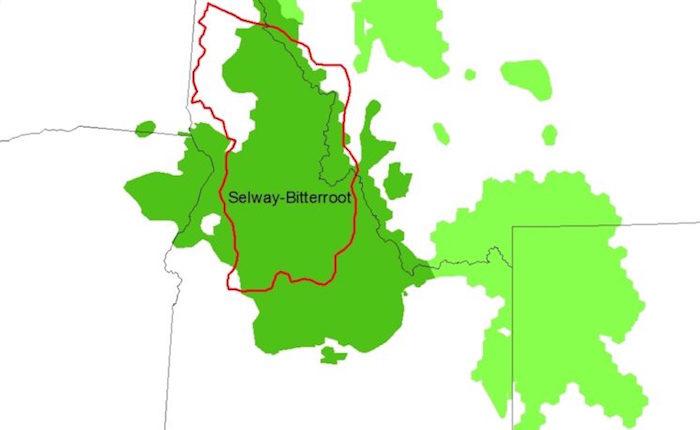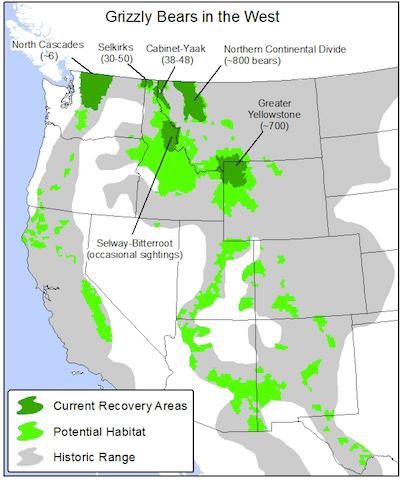
The Selway-Bitterroot area in Idaho and Montana has the closest distinct grizzly population to Yellowstone-area bears. The U.S. Fish and Wildlife Service wants to know what effect delisting Yellowstone-area grizzlies might have on other populations and has started a 30-day comment period on the topic./Center for Biological Diversity
Editor's note: The following article was written by Angus M.Thuermer Jr., for WyoFile, and reprinted here with their permission.
The U.S. Fish and Wildlife Service is soliciting further public comment on the removal of Endangered Species Act protections for Yellowstone-area grizzly bears following a court ruling.
The federal agency decided this summer that grizzly bears in a 19,279-square-mile area around Yellowstone National Park should be managed by Wyoming, Idaho and Montana. But the Washington D.C. Court of Appeals threw a wrench in the federal government’s plans when it ruled in August on a related question regarding wolves in the Midwest. The agency announced the decision to solicit further comment on December 6.
At issue in the case is whether the agency can remove protections from a “distinct population segment” of a species and if so, how it must analyze the effect of that decision on other protected populations. The court’s ruling on wolves might affect the Fish and Wildlife Service grizzly bear delisting decision, the federal agency said, because, like Western Great Lakes wolves, Yellowstone grizzlies are considered a “distinct population segment.”
Comments on the issue are due by Jan. 5, 2018.
Meanwhile, the Yellowstone-area final delisting rule “remains in effect and the status of grizzly bears throughout the rest of the range remains unchanged,” Fish and Wildlife Service said in a statement.

Grizzly bears exist in six different areas in the U.S. After delisting grizzlies in the Yellowstone area this summer, the U.S. Fish and Wildlife Service wants more input on what effect that might have on other populations. It has opened another 30-day comment period on the Yellowstone-area delisting decision./Center for Biological Diversity
Wyoming Holds Its Course
Wyoming Game and Fish Department will keep to its schedule, Chief Game Warden Brian Nesvik told WyoFile on Wednesday. “It really has no impact on our plans,” he said.
Game and Fish is gathering information and opinions on grizzly management, including whether they should be hunted, and is expected to offer proposed regulations early next year. Agency officials have said they expect the state will allow a hunt, but are uncertain when that might be.
Grizzly bears exist in six different areas in the U.S. After delisting grizzlies in the Yellowstone area this summer, the U.S. Fish and Wildlife Service wants more input on what effect that might have on other populations. It has opened another 30-day comment period on the Yellowstone-area delisting decision. (Center for Biological Diversity)
The Game and Fish Department has not decided what to recommend to the commission, Nesvik said, and is compiling and analyzing comments from meetings that ended Monday in Lander. Hunting or non-hunting proposals could be put out for public review in January, February or March and could be heard by the commission in April or July, he said.
Officials gave a hint of what a hunting season might entail when they calculated that a hypothetical hunt in 2017 could have targeted 10 bears. That hypothetical hunting would have taken place in Wyoming’s portion of the 19,279-square-mile “demographic monitoring area” where the Yellowstone-area population is counted.
The complications in delisting Yellowstone-area grizzlies arose after the Washington, D.C. Circuit Court of Appeals ruled in August on a suit brought by the Humane Society of the U.S. against Secretary of the Interior Ryan Zinke. The court decided the Fish and Wildlife Service had not addressed what effect delisting a distinct population segment of gray wolves in the Western Great Lakes region might have on other gray wolf populations that are still protected by the federal government.
“The fundamental error in the Service’s decision is that, in evaluating whether gray wolves in the Western Great Lakes region are a ‘distinct’ population segment, the Service failed to address the impact that extraction of the segment would have on the legal status of the remaining wolves in the already listed species,” the court wrote.
Similarly, Fish and Wildlife officials said, the “distinct population segment” of grizzlies in the Yellowstone area were removed from the threatened species list this summer while other populations remain under federal Endangered Species Act protection. “The service is reviewing the potential implications for the [Greater Yellowstone Ecosystem] final delisting rule in light of this ruling and is seeking any public comments that would aid in this review,” the agency said in an announcement.
Several groups, tribes and an individual are challenging the Yellowstone grizzly delisting rule in court and some have argued that the government’s decision to remove protections from one population segment was incorrect.
“This desperate move won’t protect Fish and Wildlife from the legal consequences of recklessly rushing to remove protections from Yellowstone grizzlies,” Andrea Santarsiere, senior attorney for the Center for Biological Diversity, said in a statement. “While we’re always glad for the public to have its say, this delay can’t correct the fatal flaws in a rule that would let states kill more grizzlies and consider allowing trophy hunters to target the bears. Yellowstone’s grizzly bears remain at risk and no amount of bureaucratic jujitsu by the Trump administration will change that fact.”
Comments may be made to: Federal eRulemaking Portal: http://www.regulations.gov. Follow the instructions for submitting comments to Docket No. FWS–R6–ES–2017- 0089 FXES 11130900000C6-178-FF09E4200. Or comment by hard copy by U.S. mail or hand-delivery to: Public Comments Processing, Attn: FWS–R6–ES–2017–0089; U.S. Fish & Wildlife Headquarters, MS: BPHC, 5275 Leesburg Pike, Falls Church, VA 22041–3803. Click here for a direct link.



Comments
The delisting of the yellowstone grizzly would be a serious enviromental and moral mistake. At this time the grizzly hasfullfilled a niche in the eceosystem of the area which is trying to sustain a form of balance. This is obvious due to the restoration of population, without a decrease in prey populations. Who are we to decide the life or death of another animal on this planet. Its shameful to think that we can play god. It has been proven that if ranchers use good herd practices that they can keep their animals safe. Lets educate them instead of losing this species to ignorance and greed.
My comment is simple and succinct: Don't de-list the Grizzlies from the Endangered Species List! Why does some government agency always feel the need to "fix"" what is not broken. Hands off our National Parks and their natural inhabitants.